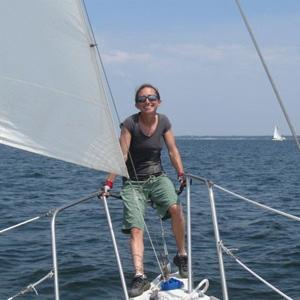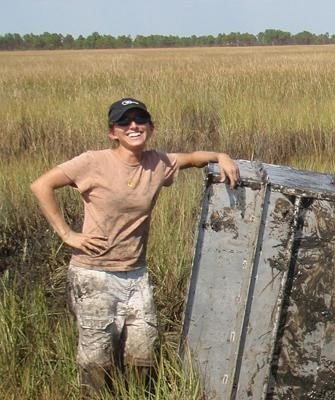Meet EPA Scientist Sandy Raimondo, Ph.D.
Sandy Raimondo, Ph. D., is a research ecologist at EPA’s Gulf Ecosystem Measurement and Modeling Division in Gulf Breeze, Florida. She is currently working on the development and application of models that predict ecological effects of chemical contaminants, with special focus on endangered species.

What research are you doing at EPA?
My work focuses on improving methods and approaches that EPA decision makers and risk assessors use to determine the impacts of a chemical on the environment. There is a lot of uncertainty in the way a chemical is evaluated for environmental protection. For example, there may be very little information available on a chemical’s toxicity, concentration and location in the environment, and the way it affects different organisms. Ecological risk assessments are conducted to register a chemical or establish water quality standards and aim to provide robust evaluations of potential chemical impacts based on available data. To reduce the uncertainty in these assessments, my colleagues and I create ecological models that translate available data into ecological effects of chemical exposure.
What is the importance of ecological modeling?
Ecosystems are some of the most complex things that we can try to wrap our brains around. An organism’s body is contained within itself, and we can dissect it and pull it apart to see how it works. But, when you go outside of the organism and you look at things in an ecological context, you’re dealing with many interactions; interactions with the physical environment, with other types of plants and animals, and with unpredictable environmental events. In a way, it’s just a complex puzzle. There’s no way that we could dissect the ecosystem and really see what’s communicating with what at any given point in time. So, we have to rely on models to describe patterns, relationships, and fill in holes where data are lacking. Then we can try to see the puzzle picture with those modeled pieces.
Can you tell us about your background?
I have always loved biology. When I was in high school, it was always my favorite subject, so I knew that was the direction I would go. As an undergrad at Penn State, I got involved in an entomology lab studying insects and absolutely loved it. This work identified my path as a field ecologist. I diverged from insects for 3-4 years to work on my master’s in herpetology, which is the study of amphibians and reptiles, and to do various internships around the country. When I decided to go back for my Ph.D., I returned to entomology. I did my dissertation on the impacts of gypsy moth management practices on non-target moth species. It looked at different types of pest management options and how they affected native species. That got me interested in pesticides, their impacts, and alternate management practices. I was hired as a postdoc at the Gulf Ecology Division (now Gulf Ecosystem Measurement and Modeling Division) studying pesticide impacts on estuarine crustaceans and fish. During my time at EPA I moved from a postdoc to a research ecologist, then to a Branch chief for an incredibly talented group of researchers, served as Director of the Gulf Ecology Division for a year, and then eventually returned back to my position as a research ecologist with a focus on improving models to assess risks to threatened and endangered species.
To date I’ve studied:
- Insects throughout the Northeast;

A good day in the life of a field biologist in an estuarine marsh along the Gulf coast. - Salamanders in the central Appalachians;
- Frogs in the Carolina Bays of South Carolina;
- Amphibians in the deserts of Texas;
- Fish and crustaceans in Gulf coast estuaries;
- Vernal pool critical habitats in California; and
- Endangered freshwater mussels throughout the US
What do you like most about your research?
I love population ecology and enjoy working with any animal species. While I could do this work in many different sectors, what I love most about my research at EPA is being part of the science that directly informs policy and helps set regulations. One of the most fulfilling experiences I’ve had in my life was being part of the team whose science was used to ban the pesticide endosulfan, a highly toxic, long-lived legacy insecticide related to DDT.
If you weren’t a scientist, what would you be doing?
If I weren’t a scientist, I would probably be an organic farmer. That goes back to my Ph.D. advisor, who was also a leader of the West Virginia University organic farm where she was directing entomology work. On an organic farm, you have to figure out how to keep your plants growing and producing without using synthetic pesticides, which can be a huge challenge, but is really fun for me. That answer may be cheating because it is technically science, but I’m not sure I’m wired to get away from that.
Do you have any advice for students considering a career in science?
I tell students who ask me for advice on graduate school to be sure that it’s what they want to do, because it’s a commitment that can take a lot out of you. The nice thing about research is there are a lot of roles for people with different backgrounds, so advanced degrees aren’t always necessary to still be on the ground and working on exciting projects.
Editor's Note: The opinions expressed herein are those of the researcher alone. EPA does not endorse the opinions or positions expressed.
